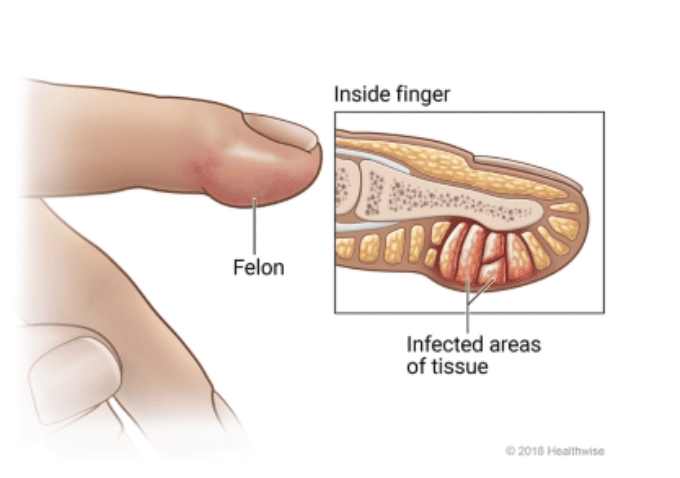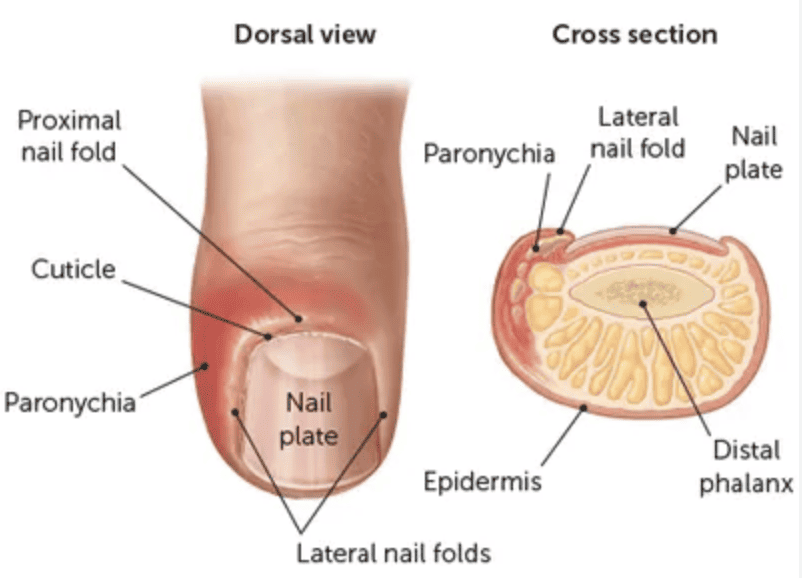Infections of the hand and upper extremities create severe problems that persist long after the condition has been treated and resolved. Infections impact patients of all ages and vary in severity depending on infection type, medical history, or age. Below is a comprehensive list of the most common infections; however, this list is
Infection Types:
Bite Wound
Infections (animals, spiders, human bites, etc.). These infections often come from the bacteria of the mouth of the biter and need to be cleaned and treated as soon as possible.
Cellulitis
Deep Space Infections
are abscesses in the muscle and may separate into compartments or “deep spaces” that can become infected from a minor wound. These infections often impact the base of the thumb (thenar space), the palm (deep palmar space, or even the web spaces between the fingers. These infections can spread to other areas, including the wrist and forearm.
Felon infections
are painful, throbbing infections of the pulp of the fingertip(s). A felon can occur after gardening, nail cutting, or other activities that involve sharp objects near the fingertip. People with diabetes are often at high risk due to multiple finger sticks to check their blood sugar.

Methicillin-Resistant Staphylococcus Aureus (aka MRSA)
is a type of bacterial infection resistant to certain antibiotics. These infections appear as boils or collections of pus. Treatment with antibiotics and the need for surgery typically depends on the location and severity of this infection. Skin MRSA must be treated immediately to prevent it from causing more severe conditions and spreading.
Septic Arthritis / Osteomyelitis
is a wound in or near a joint that can cause septic arthritis, a severe infection inside the joint. Wounds of various types and sizes, including puncture wounds, can cause this infection. These infections create immediate issues; therefore, urgent surgical drainage and antibiotics are needed. If this treatment is delayed, the condition of the bone (osteomyelitis) or rapid destruction of the cartilage can occur.
Paronychia
is an infection of the nail fold skin around the fingernail that can occur at various times to cause an infection. In acute paronychia, bacteria cause the skin around the nail to be red, swollen, and tender. If the condition is treated early enough, soaks and oral antibiotics may cure the infection. However, surgical drainage is needed to drain the pus if pus has formed under the skin. Sometimes part or all the nail requires removal.

Tendon Sheath Infections
affect the tendon sheaths of the wrist, hands, and fingers. These infections occur when a small cut or wound near the flexor tendon’s canal becomes infected. Immediate treatment is necessary to reduce severe stiffness and the surrounding tendon’s destruction. Tendon sheath infections appear as red, swollen, and tenderness that limits or prevents movement of the impacted extremity.
For additional information, please call our office and read the published article by the American Society for Surgery of the Hand to find out more about infections.
Treatment
Treatment options vary for each infection; however, they are traditionally treated with antibiotics, Epsom soaks, surgical drainage, and wound care. Surgical options may be required to remove highly infected, devitalized, or dead tissue to reduce the number of bacteria and allow the antibiotics to work. Please notify our office at the onset of an infection. Treatment options are less invasive if treated at the onset of any infection. **Various forms of imaging are requested to properly assess the severity of the infection**

